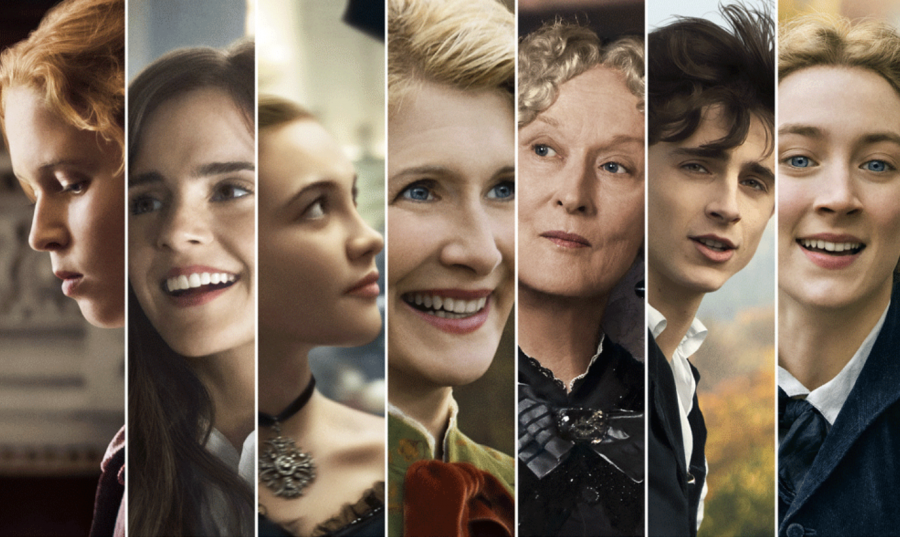Greta Gerwig’s Big “Little Women”
Cast of Little Women, Source: https://tomandlorenzo.com/2019/10/little-women-character-posters-revealed-movie-preview-posters/
January 31, 2020
The movie poster for Greta Gerwig’s “Little Women” (2019) depicts the four sisters — Meg, Jo, Beth and Amy — looking out the window, their faces infused with the same contented yet hopeful expression that pervades the film. In the movie, it is revealed that they are looking towards Laurie’s house, which is fitting as he plays such a critical role in each of their futures.
The story centers around the sisters, although arguably it focuses on Jo, the narrator, and Amy more than the other two, as they construct the main conflict. Beautiful Meg (Emma Watson) transforms from an aspiring actress to the loving wife of poverty-stricken John Brooke (James Norton). In one scene, she apologizes tearfully to him for succumbing to another woman’s jibes and purchasing some expensive fabric. Nurturing Beth (Eliza Scanlen) is, according to Jo, “the best of [them]” before she dies of scarlet fever. Feisty Amy (Florence Pugh) is resolute in pursuing her dream of becoming rich, even if it means surrendering her talented painting.
Jo is portrayed by Saoirse Ronan, who, according to a New Yorker article, “seems made to be Jo.” [1] Ronan remains loyal to Jo’s characteristic boyish tendencies, including her painful rejection of Laurie’s love. Generally, audiences have positive thoughts about Jo; many women have even claimed that she was the one who inspired them to become writers. This reflects well on Louisa May Alcott, the author of the novel and the real-life version of Jo.
Alcott was raised among famous transcendentalists such as Ralph Waldo Emerson and Henry Thoreau, who were friends with her father. Her mother, constantly irritated by her father’s lack of dedication to their family, often complained about the inequality of sexes in front of her daughters. Exposed to the progressive ideas of her mother and the ambitious perseverance of “perfection” characteristic of transcendentalists, the young writer would incorporate her childhood into many of her works, including Little Women. [2] The comfortable yet inspiring ideas of the novel are primary factors as to why it has become so popular and has been adapted into several plays and films, even now, more than a century later, with Gerwig’s take.
Gerwig places a modern spin on the story with the use of flashbacks. The film constantly “zig zags” back and forth between the girls’ childhoods and seven years later, when everyone reunites due to Beth’s death. The New York Times, which has only good things to say about the movie — declaring it “at once entirely true to its 19th-century origins and utterly modern” — praises this unique use of flashbacks, as it brings attention to the parallels of each sister’s lives before and after. [3] The Datebook, however, finds more practical issues with the flashback usage; it is too dizzying, and confuses viewers especially since the girls seem to not have aged at all. The critic also goes on to point out that other than the “sumptuous period costume”, the film hardly respects the time period in which the story is set. [4] These, however, seem to be the only things that audiences can find to criticize about the movie, besides Emma Watson’s questionable American accent.
All in all, Gerwig’s adaptation has been embraced by audiences, due partly to the brilliance of its cast, confirming once again that Alcott’s novel is truly a timeless classic.
[1] https://www.newyorker.com/magazine/2018/08/27/how-little-women-got-big
[2] https://en.m.wikipedia.org/wiki/Louisa_May_Alcott
[3] https://www.nytimes.com/2019/12/23/movies/little-women-review.html
[4] https://datebook.sfchronicle.com/movies-tv/review-gerwigs-little-women-are-snootier-than-we-remember

